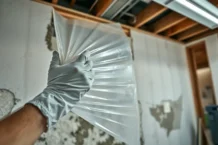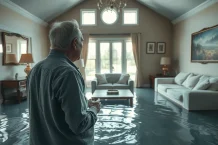Condensation line leaks from your air conditioning unit could be causing damage to your house – learn how to prevent the problem before it begins.
Water damage resulting from air conditioning condensation line leaks is more common than you might think. Condensation line leaks can be very devastating as they usually go unnoticed, mostly because they are inside walls and located in low-traffic areas.
The high humidity and dark space around those lines can also make them prone to mold growth. As the mold grows, it gets distributed through the HVAC system to the rest of the home.
What Are the Causes of AC Condensation Line Leaks?
AC condensation line leaks can be caused by several factors. Here are some common causes:
- Clogged Drain Line: The primary cause of condensation line leaks is a clogged drain line. Over time, algae, mold, dirt, and debris can accumulate in the drain line, obstructing the flow of water. This causes the condensate to back up and eventually leak out of the line.
- Improper Installation: If the AC system was not installed correctly, it can lead to condensation line leaks. This could include issues such as an improperly pitched drain line or a poorly connected drain pipe, causing water to accumulate and leak.
- Damaged or Disconnected Drain Line: Physical damage to the condensation line, such as cracks, leaks, or disconnected sections, can result in water leakage. This can occur due to accidents, wear and tear, or improper maintenance.
- High Humidity: In regions with high humidity, the AC system tends to produce more condensation. If the condensation line is not adequately sized to handle the increased water flow, it may lead to leaks.
- Frozen Evaporator Coil: If the evaporator coil in the AC unit becomes frozen, it can cause an excess buildup of condensate. When the ice thaws, it can overwhelm the condensation line, resulting in leaks.
- Dirty Air Filters: Dirty or clogged air filters restrict airflow, causing the evaporator coil to become colder than normal. This can lead to excessive condensation and potentially overwhelm the condensation line, causing leaks.
- Oversized AC Unit: If the AC unit is oversized for the space it is cooling, it may not run long enough to adequately dehumidify the air. This can result in excessive condensation and potentially overwhelm the condensation line, leading to leaks.
Regular maintenance and inspections of the AC system can help prevent condensation line leaks. It is recommended to have the system serviced by a professional HVAC technician to ensure proper installation, cleaning, and maintenance procedures are followed.
Prevention of AC Condensation Line Leaks
 So how do you prevent A/C condensation line leaks? The most important thing you can do is inspect it regularly, as even a slight sign of condensation is a sign you may have a problem. Here are four tips on maintaining your A/C condensation line:
So how do you prevent A/C condensation line leaks? The most important thing you can do is inspect it regularly, as even a slight sign of condensation is a sign you may have a problem. Here are four tips on maintaining your A/C condensation line:
- Inspect it regularly – Every time you change your HVAC air filter, which should be about every 30 days on average, you should visually inspect the AC condensation line for moisture.
- Ensure proper AC condensation line pitch and reduce elbow connection angles – Having your AC condensation line leaks run straight as possible is ideal, and a drop of 1/8-inch for every 12 inches of length is the minimum pitch. Remove any elbow connections with 90-degree angles and replace them with 45-degree elbow connections when possible.
- Check the AC condensation line opening and exit – When your AC unit is running, check the condensation line opening to make sure you see water flowing to the drain. The amount of water you see will depend on the humidity level in the house.
- Clean the line every 3 to 6 months. Calcium deposits from San Diego’s hard water can build up over time and clog your lines.
One easy way to clean an A/C condensation line leak is by using a nylon string and a small piece of cotton rag. Use a shop vacuum to suck out the nylon string on the exit side, then tie the small piece of cotton rag to the other end and just pull through. This will bring all of the debris in the line out the exit side. Do not make the rag piece too large or it will get stuck in the line with no way out. It should be small enough to fit loosely in the pipe.
Finally, if you have no room to create the minimum pitch, you may have to use a condensation pump to help move the water out. Consult your HVAC serviceman for installation and make sure you have an emergency cut-off if it fails.
Frequently Asked Questions About AC Condensation Line Damage
What are the signs of AC condensation line water damage?
- Water stains or pooling near the indoor unit or along the condensation line.
- Damp or musty odors in the vicinity of the AC system.
- Visible mold or mildew growth on walls, ceilings, or near the AC unit.
- Warping, discoloration, or damage to walls, ceilings, or flooring.
- Unexplained increases in humidity levels or the presence of excessive moisture in the air.
What should I do if I discover water damage from an AC condensation line leak?
- Turn off the AC unit to prevent further water leakage.
- If there is standing water, remove it using a wet/dry vacuum or towels.
- Contact a professional water damage restoration company to assess the extent of the damage and assist with cleanup and repairs.
- Take photos or videos of the damage for insurance purposes.
- Address any mold or mildew growth by hiring a professional mold remediation specialist.
- Consider filing an insurance claim if the damage is significant.
Will my insurance cover AC condensation line water damage?
Whether or not your insurance will cover AC condensation line water damage depends on your specific insurance policy and the circumstances surrounding the damage.
Generally, if the damage is sudden and accidental, such as a sudden leak or a burst pipe, it may be covered under your homeowner’s insurance policy. However, if the damage is due to a lack of maintenance or neglect, it may not be covered.
It’s important to review your insurance policy or contact your insurance provider to understand the coverage and any specific exclusions related to AC condensation line leaks. Additionally, documenting the damage and providing supporting evidence such as photographs can be helpful when filing an insurance claim.
Conclusion
AC condensation line leaks can lead to significant water damage if not addressed promptly. Clogged drain lines, improper installation, high humidity, frozen evaporator coils, and other factors can contribute to these leaks. Preventive measures such as regular maintenance, cleaning the condensation line, and ensuring proper installation are essential to avoid water damage.
If you suspect or discover water damage from an AC condensation line leak, it’s crucial to take immediate action. Turn off the AC unit, remove standing water, and contact professionals for assistance. Promptly addressing the damage can help mitigate further issues such as mold growth and structural damage.
Remember to review your insurance policy to understand coverage for AC condensation line water damage. Documentation and evidence of the damage can support your insurance claim if applicable.
To safeguard your property, we recommend scheduling regular maintenance with an HVAC technician and being proactive in maintaining a clean and functional condensation line. By taking these preventive measures, you can minimize the risk of AC condensation line leaks and potential water damage.
Don’t wait until it’s too late. Take action today to protect your home or business from the damaging effects of AC condensation line leaks. Your comfort and peace of mind are worth the effort.









Follow Us!